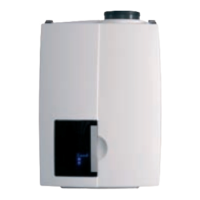Installation & Servicing Instructions Rinnai E-Series
27
6.5 Hot water supply
Connection of the drinking water installation should be performed according to the
national secondary drinking water regulations.
Do NOT use toxic chemicals, such as are used for boiler treatment in potable
water heating systems used for space heating.
The sanitary water pipes can be connected to the installation by use of adapter
ttings. The cold water inlet on the Combi boilers must be equiped with the following
components (counted in the water ow direction):
Flow regulator valve (supplied), Safety group, Expansion vessel 87 PSI / 6bar (potable
water, blue).
The 3/4" NPT adapter tting with ow reducing valve must be tted in the cold water
connection.
A ow regulator valve is supplied with the boiler in a 3/4"NPT adapter tting. The
ow regulator valve ensures that a quantity of water is supplied which has a outlet
temperature of 120°F (assuming a cold water temperature of 45°F). The quantity of
water is virtually unaffected by the water pressure.
When there is a water pressure lower than 22PSI / 1.5 bar it is advisable to
remove the inside mechanism of the ow reducing valve.
6.5.1 Domestic Water quality
Appropriate steps must be taken to ensure the brazed plate heat exchanger does
not become plugged by scale caused by hard water or sediment. If the plate heat
exchanger becomes plugged by either scaling from hard water of sediment it is not
the responsibility of Rinnai.
1. Water hardness for DHW
When there is a water hardness of more than 6-7 grains hardness is used for domestic
water a water softener must be installed on the inlet side of the DHW connection.
2. Sediment in DHW
If there is sediment in your domestic water supply sediment lter or other suitable
device should be used to remove it before the water enters the brazed plate heat
exchanger.
NOTICE
i
!
DANGER

